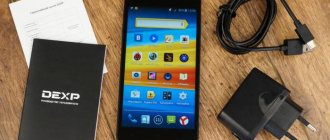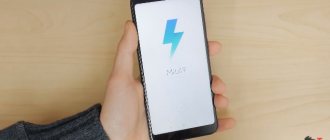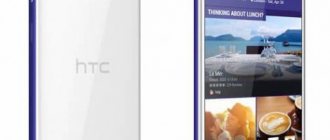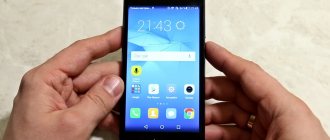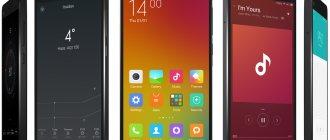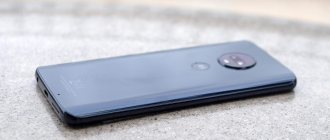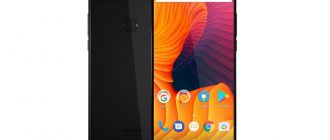Main characteristics of Yandex.Phone
| Screen | S-IPS, 5.65″, 1080×2160, multi-touch 5 touches, Gorilla Glass 3 |
| Iron | Qualcomm Snapdragon 630 4 x Cortex-A53 2.2 GHz, 4 x Cortex-A53 1.8 GHz, Adreno 508 |
| Memory | RAM 4 GB, ROM 64 GB, Micro-SD |
| Mobile Internet | LTE cat.6 300/50 Mbit/s HSDPA, HSUPA EDGE |
| Mobile networks | LTE Bands 3,7,20,38,40 UMTS 900, 2100 GSM 900, 1800, 1900 |
| Battery | Li-Ion, 3060 mAh, Quick Charge 3.0 |
| Dimensions | 150.1 x 72.5 x 8.3 mm |
| Weight | 163 g |
| Camera | dual 16 MP + 5 MP front: 5 MP |
| Navigation | GPS, GLONASS, BeiDou |
| OS | Android 8.1 Oreo, Yandex.Launcher |
| Sensors | Accelerometer, Gyroscope, Compass, Zoom, Light, Fingerprint Scanner, Hall, NFC |
| SIM | 2 x Nano-SIM |
| Price | 17990₽ minus Yandex.Buns |
The first phone released under the Yandex brand. Slightly outdated mid-range hardware. Android certified by Google. Own shell. Lots of native software. Including, of course, Alice - as the default voice assistant.
Didn't take off. Yandex.Phone did not take off. This is already obvious.
Yandex received its bucket of slop from You Know Who. Received moderately cautious reviews from other reviewers. And a bunch of screams: “Why is it so expensive? Xiaomi is better and cheaper” in the comments to these reviews.
There are many questions. The main question, in my opinion, was this phone supposed to take off at all? Did Yandex have such a goal?
I don't like what Yandex has become in recent years. Once upon a time he was white and fluffy. But it gradually turned into a “classical capitalist corporation.”
But the fact that Yandex is closely involved in smartphones is very logical. I don’t pretend to be the ultimate truth, but let’s speculate.
1) Yandex has money. Including experiments. Which may well be unprofitable, that’s why they are experiments. 2) Smartphones are forever. Or at least until the next global cataclysm. 3) Yandex is software. This is a lot of different software for smartphones. Alice, Cards, Money, Zen. Well, Search, yes. 4) Smartphones are monopolized by Google, which (also) is an evil and terrible competitor of Yandex. 5) It is not a fact that Google's monopoly will last forever. Young punks will grow up. Or Huawei, banned by American politicians, will fork Android. Or Apple will allow everyone to make smartphones on iOS. Or the Iron Curtain will fall and Google will simply stop working in our country. Or something else will happen.
Releasing a standard smartphone under your own brand is not a Newtonian binary. There are hundreds of smartphone brands in the world. But why does Yandex need a standard smartphone? Let's better gather a team and let them experiment. Let them dig as deep as they can, just as simple software writers cannot dig. They integrate software with hardware, tinker with cameras, argue with Google about what is possible and what is not. And once a year they release a new smartphone. Just to be as on topic as possible. So that when any force majeure event occurs, one of those listed in paragraph five, try to react to it as best as possible.
And if so, then everything falls into place. Yandex does not need big sales, because the more smartphones you produce, the higher the financial risks. Therefore, we simply get involved in a fight with clear planned losses, gain experience and wait.
And buyers are, in essence, advanced beta testers. To avoid too much swearing, the smartphone should be “within reason.” Quite high quality, not particularly buggy. And not crazy expensive.
Price
The price is unusual. It seems simple and clear - 17,990 rubles without options. But in reality this is not so, because there are also delicious Yandex.Buns.
- 500 rubles to your account in Yandex.Money.
- 10% cashback when paying for purchases with Yandex.Phone (no more than 500 rubles per month and no more than 1,500 rubles in total). And you have to really dislike money not to take this cashback.
- 300 rubles for Yandex.Taxi, which it would also be strange not to use.
There is also a subscription to Yandex.Plus for six months (1000 rubles), but these are just services that they were given to use for free. But the rest of the goodies are completely honest, pure money. So if the buyer of Yandex.Phone is not a complete idiot, then the device will cost him 17,990 - (500+1500+300) = 15,690 rubles.
That is, Yandex artificially shows potential buyers that a smartphone is more expensive than it actually is. And thus cuts off some buyers. Because, of course, many people, when choosing a smartphone, are guided by the price that was first shown to them. Instead of going deeper into the study of cashbacks.
And either this is a flaw of Yandex marketers, or - see above - Yandex simply does not need many buyers.
Bonuses
As in the case of Station, when purchasing a smartphone, Yandex returns part of the cost in the form of subscriptions to paid services and other bonuses included. Here's what the user will receive with the device:
- 500 rubles to your Yandex.Money account.
- 10% cashback in Yandex.Money when paying via NFC for three months (but not more than 500 rubles per month).
- 300 rubles for trips to Yandex.Taxi.
- 10% discount on trips to Yandex.Taxi at the Comfort tariff and higher for six months.
- six months of subscription to Yandex.Music.
- Access to films and TV series on KinoPoisk for six months.
- Free delivery of purchases from the “Beru!” marketplace for six months.
- Discounts and special rates in the Yandex.Drive car sharing service, valid for six months.
- 10 additional GB and a 30% discount on all tariffs on Yandex.Disk for six months.
Competitors
Now let's look for smartphones from serious brands that have NFC, a decent processor and no less amount of memory than Yandex.Phone. And let's see how many devices we can find that are cheaper than sixteen thousand.
Xiaomi. Only the “gray” Xiaomi Mi Note 2 and Xiaomi Mi 5s Plus of 2020 fit our criteria. There are endless discussions on the forums about the broken Google Pay. Xiaomi Mi 6 and Xiaomi Mi Note 3 will be a little more expensive. But also only “gray”.
Huawei.
Honor 8X can be found on sale for RUB 15,500 (with an official price of RUB 18,000). Excellent price/quality, but Yandex.Phone is not a competitor, because it’s a shovel.
Honor 9 Lite on the budget HiSilicon Kirin 659 chip. 15,000 RUR for “white” 4+64 GB. Be careful with “gray” purchases, you can run into Chinese ones without NFC.
Honor 9 is a little more expensive - 17,000₽, but also more serious.
Huawei P20 Lite, also on Kirin 659. Officially costs 18,000 rubles. Unofficially - from 15,000 rubles (it seems to be with NFC, but it’s better to clarify).
Samsung. The cheapest is Samsung Galaxy A7 (2018). Officially costs 20,000 rubles, but can be found for about 16,500 rubles. More expensive, but with an AMOLED screen and even a triple camera.
ASUS. Everything is serious here.
ASUS ZenFone Max Pro M1. Officially, the 64 GB version costs 14,990 rubles, but you can find it around 13,000 rubles.
ASUS ZenFone Max Pro M2 (ZB631KL). Officially it costs 17,000 rubles, but you can save one and a half thousand if you look for it.
So, there are competitors.
⇡#Camera
One of the most controversial elements of Yandex.Phone is the camera. Although what is the point of these cunning formulations - rather, this is one of the indisputably weak elements of Yandex.Phone. There is a conditionally double module consisting of a 16-megapixel camera with an ƒ/2.2 aperture lens and a 5-megapixel camera with an unknown aperture lens. The second camera is used for... nothing. Most likely, Yandex engineers did not have time to prepare the software, and no software background blur mode is provided in the camera application. Not to mention optical zoom - the second camera is apparently simply not suitable for this.
The application itself is not without originality - for example, exposure compensation is entered not using a slider near the autofocus window, but by selecting one of five points located on the right side of the body. In the settings you can select the resolution and compression level of the images, on the main screen you can activate or deactivate HDR with flash... that's all. The originality of the application also lies in its asceticism: there are no filters, no manual settings, or any other additional modes. It looks more like a beta version of the interface than something finished, like the Nokia relaunch last year (there was also a very skimpy camera app, but by this year it had developed into something usable).
| On the left is a photo with HDR, on the right is a photo without HDR | ||
The main camera itself demonstrates a level of performance typical of budget smartphones - there is neither optical stabilization nor sufficient aperture to count on normal shooting quality in the dark without this stabilization. Taking a picture in low light without blur is already a difficult task, but getting normal exposure and colors on it is a mission that tends to be impossible. Today everyone can take good pictures in good lighting – Yandex.Phone is no exception. The colors are fair and the detail is good.
Gallery of pictures
View all images (19)But Yandex.Phone can record 4K video at up to 30 frames per second. The quality is also far from outstanding, but in the mid/budget segment there are still very few people who can shoot with such a resolution.
| Examples of self-portraits with and without flash | ||
The front camera - five megapixels, without autofocus, but with a flash - makes a more pleasant impression than the main one. But there are also not enough stars in the sky - just a normal front camera.
Appearance
| Weight | 163 g |
| Size | 150.1 x 72.5 x 8.3 mm |
| Protection | No |
Be careful, the smartphone is very slippery. If you wear it without a cover, it’s only a matter of time before it hits the floor or asphalt. Considering that replacing the screen costs 6,480 rubles, it is better to purchase a case. The official transparent one costs 290₽ (+99₽ for pick-up), the colored ones are more expensive - 1490₽.
The only color is black and glossy. It is covered with fingerprints, but they are not very visible, and the smartphone does not look untidy.
Materials. It looks like glass and a metal frame.
The cameras don't stick out. Hooray.
There is no LED.
Boring details
Above the screen there is a front camera with a flash, a speaker, and sensors. The flash is too prominent...
Below the screen is empty.
Rear Dual camera with flash - in the left corner. The fingerprint scanner is in the classic place, which is so convenient to hit with your index finger.
Top edge. There is a 3.5 mm audio output and an auxiliary microphone.
Bottom edge. USB Type-C, speaker, main microphone.
On the right are the buttons, the most common buttons. Volume rocker and power on/lock.
On the left is a tray for cards. Two Nano-SIM or one SIM and a Micro-SD memory card.
Smartphone from Yandex! Yandex.Phone review
The editor-in-chief of the Miracle of Technology website, Kim Korshunov, is reviewing the first Android-based smartphone from the domestic search engine Yandex. The new product is called “Yandex.Phone”.
What will surprise him? Let's find out in this video:
Yandex.Phone has a 5.65-inch IPS display with a resolution of 2160×1080 pixels and an aspect ratio of 18:9. The body is made of glass, with 2.5D curved glass on the front. The fingerprint scanner is placed on the back.
Inside there is a Qualcomm Snapdragon 630 processor, 4 GB of RAM and 64 GB of internal memory. The battery capacity is 3050 mAh - Yandex promises up to 24 days of standby time, up to 20 hours of talk time in 3G and up to 10 hours of Internet surfing. There is support for fast charging (from 0 to 90% in 1 hour 15 minutes).
The main camera in Yandex.Phone is double - modules with a resolution of 16+5 megapixels are hidden under glass and do not protrude from the body. An additional module is used for shooting with the bokeh effect (background blurring). The front camera resolution is 5 megapixels and there is a front flash.
The smartphone has a modern USB Type-C connector and a 3.5 mm audio jack for connecting headphones. There is a slot for two SIM cards or one SIM card + MicroSD memory card. The presence of NFC is also important - you can pay for purchases contactlessly. The smartphone has basic protection against moisture and splashes, but it cannot be immersed in water.
The device runs on Android Oreo with a proprietary shell. Of course, Yandex is installed as the default search engine, and Alice is installed as the voice assistant. Other company services are pre-installed - maps, weather, music, and so on. At the same time, the company tried not to overload the smartphone and leave only the necessary minimum.
Another interesting feature: the device automatically determines who owns the unfamiliar numbers that are calling you and you can understand whether you should pick up the phone or not. If you go to the left from the main screen, you can get to the “Zen” feed, where news and interesting publications are collected.
You can buy Yandex.Phone for 17,990 rubles.
It’s interesting that when you first launch a smartphone, the company offers gifts - 500 rubles to your Yandex.Money account, 300 rubles to Yandex.Taxi, and unlimited photo storage on Yandex.Disk. The company also gives six months of Yandex.Plus subscription, which includes unlimited access to music, discounts on taxis, car sharing, watching online movies through Kinopoisk and other bonuses.
Screen
| Matrix | S-IPS |
| Diagonal | 5.65″ |
| PPI | 427 |
| Permission | 1080×2160 |
| Multi-touch | 5 |
| Max white brightness | 345 cd/m2 |
| Min white brightness | 13.5 cd/m2 |
| Contrast | 900:1 |
| Gloves | No |
A simple, understandable IPS matrix of average quality and average brightness. But the resolution is high.
Don't believe those who say there is no color temperature adjustment. She is. But what's the point?..
The screen is strictly rectangular. There are not only no cutouts, but even minimal rounding of the corners.
There is an oleophobic coating.
Operating system and other software
Honest certified Android 8.1. With the Play Market store on the first page, with an enemy search form on the main screen (however, it can be removed), etc.
Plus its own shell called Yandex.Launcher. Cute. I especially liked searching for applications by icon color.
It’s convenient that many caller numbers are automatically detected - spammers, companies, etc. They called from Yandex - Yandex has identified it, even though I don’t have it in my address book.
It’s convenient that when searching by contacts, the search is carried out not only in your address book, but also “in general.” If you want to call a Maxidom store, you type its name right there, select the desired address, and call.
And so on.
Of course, a variety of Yandex software is installed - Money, Taxi, Music, Maps...
More screenshots
Android and the shell: some are great, some are stupid. Overall, it takes some getting used to
Android 8.1 with the Yandex shell instead of Google is not a problem at all. I remember that two years ago “Yandex Launcher” was installed on Fly, which was initially lousy in terms of filling, and the shell “slowed down” so much that I wanted to break the smartphone immediately after purchase. But since then, Yandex programmers have learned to create software for Android more carefully, and smartphones with a proprietary shell have ceased to be weaklings, so everything works perfectly quickly on Yandex.Phone. Yes, and Google applications have been preserved, and Yandex did not even push its own proprietary application store and limited itself to Google Play.
Alice
And, of course, Alice, the voice assistant, is installed.
According to Yandex, Alice is hard-wired into the smartphone, thanks to which it is always ready to respond to the code phrase “Listen, Alice” - even when the screen is off.
What if the smartphone is locked? Alice will hear you, no question. But in order to communicate with her, you still have to put your finger on the smartphone to unlock it. Uncomfortable? Oh yeah. However, there is a small life hack. We look in the Smart Lock settings and indicate “safe places” in which the smartphone will not be locked. In fact, should you lock your smartphone at home? I think no.
I honestly tried to use Alice in everyday life. - “Listen, Alice, the weather for tomorrow.” - “Listen, Alice, one hundred yuan in dollars.”
And so on.
Works. But it didn't work. I'm too much of a geek. I feel comfortable using the keyboard. Although, of course, it’s fun to dig deeper and there’s something in it. But there are too many restrictions. Here, with a flashlight, for example.
“Alice, I have a phone”: why did Yandex make its own smartphone
Head of Yandex Launcher development Fedor Ezhov (Photo: Andrey Lyubimov / RBC)
Eight Yandex applications are preinstalled on the smartphone. You can disable their activity, but you cannot completely remove them from your phone. Buyers will receive a six-month subscription to the Yandex.Plus service, which allows them to receive discounts on various company services, for example, when using Yandex.Music or Yandex.Taxi.
Read on RBC Pro
How to become a Speaker: advice from re:Store founder Evgeniy Butman How to manage talent in the era of “large-scale rebellion” - part I Bill Gates - about the madness of conspiracy theorists and the new Steve Jobs Strategy of Ivanushka the Fool: how a top manager can get out of a dead end in 9 steps
The cost of the device is 17,990 rubles, from December 6, sales will begin in the Yandex store and museum, from December 7 - in the VimpelCom showrooms (Beeline brand), M.Video-Eldorado, as well as online "Beru" store.
Representatives of other large electronics retail chains did not explain why they did not reach an agreement with Yandex. The purchasing director of the merged company, Mikhail Komkov, only said that at the moment the retailer is not negotiating the sale of Yandex.Telephone. An MTS representative declined to comment. A MegaFon representative said that the company is discussing commercial terms for the distribution of the smartphone in its network. “We will closely monitor the start of sales. The price segment chosen is quite difficult due to the huge competition between Chinese and Korean brands,” he noted.
Why does Yandex need its own smartphone?
According to Yezhov, the company does not intend to compete with other devices on price. The company explains the release of the phone by saying that they wanted to offer people who actively use its services a device in which the main Yandex applications would be collected in a convenient combination and combined with Alice.
Internet companies are reaching a new level of competition, says Otkritie.Broker analyst Timur Nigmatullin. “We are no longer talking about the development of individual high-tech services, but about creating an ecosystem based on them so that these developments are tied to each other. A striking example is a subscription to Yandex.Plus, when using some applications you can get discounts and bonuses in others,” says Nigmatullin.
Photo: Andrey Lyubimov / RBC
However, he does not see Yandex relying on the sale of hardware and trying to transform itself into not investing in a development company, for example, but simply purchasing Chinese hardware,” Nigmatullin recalled.
The main thing for the company is to offer the user as many channels as possible to access Yandex services in order to reduce customer churn and take a more stable position in the market, the analyst is sure, noting that users love the integration of services into different devices.
According to Yandex.Radar, at the end of November 2020, Yandex’s share in search engines in Russia was 56.7%, and Google’s share was 39.8%. In November 2020, these figures were 56.7 and 39%, respectively.
“It is obvious that Yandex does not rely on revenue from the sale of smartphones. Traditionally, Internet companies that present their gadgets are much more interested in the data that they can receive using applications preinstalled on devices,” says Karen Kazaryan, chief analyst of the Russian Association of Electronic Communications (RAEC).
In his opinion, if Yandex suddenly wants to transform into , this will require huge expenses from the company: at a minimum, it will be necessary to recruit a staff of specialized engineers and device designers.
Photo: Andrey Lyubimov / RBC
What place will the smartphone take in the market?
A Yandex representative refused to name the size of the first batch of Yandex.Telephone and talk about the company’s expectations from sales of the device.
Timur Nigmatullin believes that the sale of the device itself is unlikely to bring any tangible effect for the company’s business, but does not exclude that this step will allow “more clients to be connected to Yandex applications.”
Leading analyst at Mobile Research Group Eldar Murtazin is confident that a smartphone from Yandex has virtually no chance of conquering the mobile device market. “This is a typical C-brand (third-tier brand - RBC), which is characterized by a non-unique design and, most importantly, minimal modification of the Chinese base. For this category the price is 18 thousand rubles. too high. How Yandex is not interesting to the mass consumer. The smartphone is not unique, and there is no incentive to buy it,” the expert is categorical. In addition, Yandex has obligations with Google, which is the developer of the Android platform on which the smartphone runs, and if it violates the agreement, the smartphone will simply be turned off, Murtazin recalled. When concluding an agreement to use the Android platform, companies undertake to pre-install a number of products from Google. In addition, Google restricts its counterparties from pre-installing certain applications (mostly those that compete with its own).
According to Eldar Murtazin, Yandex has signed a contract for the supply of a batch of 20 thousand devices. Of this amount, the company will be able to sell about half and only if the price tag for the smartphone is reduced by March, Murtazin estimated. According to estimates, by the end of 2020, a total of 29.4 million smartphones will be sold in the country for 466 billion rubles.
Karen Kazaryan, on the contrary, called the price of Yandex.Telephone quite competitive. “By February, it is quite possible for the company to sell up to 20 thousand of its devices. Especially if they fall into the wave of pre-New Year sales,” he noted.
Photo: Andrey Lyubimov / RBC
Not just a phone
Yandex.Phone became the second officially presented Yandex device. The first was Yandex.Station, a multimedia system equipped with a built-in voice assistant called Alice, sales of which began in July of this year. The cost of the smart speaker is 9990 rubles. As two RBC sources familiar with Yandex’s plans said, the company intended to release its own tablet back in 2012–2013. However, after a sharp collapse in the ruble exchange rate in 2014, the plans were frozen. According to one of RBC’s interlocutors, the project was called “Erica” and after its closure, its software part moved to the Yandex.Kit project (closed in 2015), within the framework of which Yandex developed its own mobile operating system based on open source code Android operating system.
Yandex does not disclose sales data for Yandex.Station.
Alice and the lantern
Something is wrong here. I think you are aware that Google Assistant can turn on the flashlight. Also, I’m sure you know that there are about a million flashlight apps on the Play Market. Alice doesn’t know how to turn on a flashlight. Clearly recognizes the situation. And... it doesn’t turn it on. Sometimes he answers that “I don’t know how to turn on a flashlight yet.” Sometimes he turns it down, saying, “I’ve already tried it.” Sometimes she says that she has already turned it on.
Damn it. I don't believe that Alice's programmers are incapable of writing code that turns on the flashlight. And for some reason it seems to me that all voice assistants receive requests to turn on the flashlight no less often than requests to turn on the alarm clock. Then what's the matter? Put it in a distant drawer and forgotten? Google's machinations? Something else? Don't know.
There are other problems too. When asked to open the camera, it is not the usual camera application that opens, but an object recognition application. This is also a necessary thing, but sometimes you just want to turn on the camera...
Alice is also more difficult to persuade than Google Assistant to open the right application, call the right person, etc. If you ask Google to open Total Commander, it will open the app. And Alice is a page on some website. And so on. It’s clear that there are growing pains and there is work to be done. But it’s still damp, very damp.
It also infuriates me that Alice is a rude person. At least he doesn’t send obscenities, but thank you.
More screenshots with Alice
How to bring Alice to the main screen of your phone
First, you need to download the Alice widget to your smartphone desktop. This can be done by downloading the Yandex browser with Alice. As soon as the browser with the assistant loads, the necessary widget will appear on the phone’s desktop.
How to download the application correctly:
- open a Play Market store;
- go to the search bar located at the top of the page;
- enter the name of the program and click on the “magnifying glass” icon;
- wait for the search results to load and select the appropriate option from the list;
- click on the “install” icon;
- wait for the download to complete and click the “open” menu or return to the main screen and select the installed application icon.
If the Alice assistant is already installed on your phone, just in case, you can also update it through the Play Market application.
You can display the widget on the screen for quick access by following these steps:
- hold the phone screen with your finger until the setup mode appears;
- select “widgets” from the menu
- find Yandex in them and select Yandex.Search 1x1.
After completing all the actions, the widget will be added to the screen, and you will be able to use the Yandex Alice voice assistant in quick access.
About Yandex.Money on Yandex.Phone
Not exactly on the topic of the review, but I want to say a few words.
I, like many of you, use Google Pay quite heavily. I touched a smartphone with NFC to the terminal - click, the money was debited from the linked card. What’s strange is that until I got my hands on Yandex.Phone, I didn’t even know that Yandex.Money could work almost exactly the same way. I touched a smartphone with NFC to the terminal - click - and the money was also written off. Just not from a card, but from a Yandex.Money wallet. It seems that Yandex.Money is not promoting itself actively enough. Honestly, I would prefer that the percentage for my purchases go to “my” Yandex, and not to foreign Google.
However, Yandex still has a lot of work to do on Money. Let's say they link bank cards to a wallet. And you can even top up your wallet for free. But Yandex does not have straight-through debiting from the card for contactless payment, like Google. Don't forget to replenish your wallet. Inconvenient.
Further. Strange bug. To make contactless payments, Yandex.Money issues you a virtual banking “contactless card” that is tied to your... not even your wallet, it is tied to your smartphone. Ok, the card has been issued, I’ll start paying. Of the first five stores, payment does not go through in two. Moreover, the effect is stable. Large stores. I tried several cash registers in each one. Came two days in a row. Still doesn't work. I'm contacting support. “Re-issue the contactless card,” says the support service. I didn’t understand the logic, but I re-released it - and, you won’t believe it, everything worked. And there have never been any more problems with payment.
But there were problems with cashback. It suddenly stopped accruing. I contact support again. And I even contact you twice. First through the chat in the application, then through Vkontakte. On the second attempt the problem was resolved. The under-accrued cashback was transferred, and the new one began to be credited without problems. And, of course, they politely apologized to me.
In short, there is something to work on.
Review of the Yandex.Phone smartphone
At the very end of last year, the domestic software giant Yandex, obviously trying not to yield to its competitor Google, released its own Google Pixel smartphone with the voice assistant Alice. Created at a Chinese enterprise, the technically unremarkable Yandex.Phone (this is the official name given to the smartphone) claims that its main feature is the presence of the Alice voice assistant “out of the box”. According to company representatives, it is easy to find a common language with Yandex.Telephone: “Alice speaks and understands Russian from birth. She carries out orders and anticipates the wishes of the Phone owner. Yandex technologies and services help her with this.”
Today we will look at whether the new smart phone has enough of these capabilities to justify the considerable price that the developer is asking for this product.
Main characteristics of Yandex.Phone (model YNDX000-SB)
- SoC Qualcomm Snapdragon 630, 8 cores: 4 Cortex-A53 @2.2 GHz, 4 Cortex-A53 @1.8 GHz
- GPU Adreno 508
- Operating system Android 8.1, Yandex.Launcher
- Touch display IPS 5.65″, 2160×1080 (18:9), 427 ppi
- Random access memory (RAM) 4 GB, internal memory 64 GB
- microSD support (up to 128 GB)
- Nano-SIM support (2 pcs.)
- GSM/WCDMA networks
- Networks LTE Cat.12/13 FDD B1/3/7/20, LTE TD B38/40, LTE-A (3+7/3+20/3+38/7+7/7+20)
- GPS/A-GPS, Glonass, BDS
- Wi-Fi 802.11a/b/g/n/ac (2.4 and 5 GHz)
- Bluetooth 4.1
- NFC
- USB Type-C, USB OTG
- Audio output to headphones (3.5 mm)
- Main camera 16 MP, f/2.2 + 5 MP; 4K video
- Front camera 5 MP, f/2.4
- Proximity and lighting sensors, magnetometer, gyroscope, accelerometer
- Fingerprint's scanner
- Battery 2970 mAh
- Dimensions 150×73×8.3 mm
- Weight 163 g
| average price | find out prices |
| Retail offers | find out the price |
Appearance and ease of use
Yandex.Phone has a not very flashy, but rather neat and pleasant design. However, for such a price, Huawei/Honor can offer models with a more attractive design with a mirror backing under glass, gradient color, etc. Against their background, the hero of the review looks laconic and strict, but perhaps even more stylish, because not everyone after all, I like sparkles.
The back wall is made of a glass-like material. It may be lacquered plastic, but fingerprints appear on its surface with difficulty; the device remains presentable for a long time.
The side frame is metallic and matte, it slides in the hand, the smartphone cannot be called truly practical, it clearly needs a protective case.
The screen does not have a notch on the screen and looks great without it, as well as without the rounded corners of the display. At the same time, there is an LED event indicator and even its own flash for the front camera.
At the back, the elements are placed in a rather unusual way: the protective glass for the camera eyes is the glass of the rear panel itself. On the one hand, this makes them much more convenient to wipe, but on the other hand, scratches will appear faster, since there are no rims or protrusions around the camera modules. Moreover, the smartphone lies on the table, completely adjacent to it with the entire surface of its flat back wall.
The fingerprint scanner is recessed, it is easy to feel blindly and your finger does not get caught in the cameras, as happens with Samsung smartphones.
Yandex.Phone does not support the simultaneous installation of two Nano-SIM cards and a microSD memory card; one will have to be sacrificed. Hot swapping of cards is supported.
The hardware buttons on the side are large, but smooth and indistinguishable tactilely. They can be easily felt blindly, but the movement is too flexible, and unintentional pressing may occur.
The top end is equipped with a 3.5 mm audio output and an additional microphone.
The interface connector is installed at the bottom end. I’m glad that it turned out to be a modern and fast USB Type-C, but its asymmetrical location relative to the longitudinal central axis causes rejection; such little things clearly characterize the manufacturer.
As for the different colors of the case, there are simply none; the smartphone is only available in completely black, and to express your individuality, Yandex offers multi-colored cases. The case did not receive protection from dust and moisture.
Screen
Yandex.Phone is equipped with an IPS display covered with 2.5D Corning Gorilla Glass 3. The physical dimensions of the screen are 64x129 mm, diagonal - 5.65 inches, resolution - 2160x1080 (with an aspect ratio of 18:9), pixel density - 427 ppi. The frame around the screen has a width of 3.5 mm on the sides, 10 mm on the bottom, and 10 mm on the top.
A detailed examination using measuring instruments was carried out by the editor of the “Monitors” and “Projectors and TV” sections Alexey Kudryavtsev . Here is his expert opinion on the screen of the sample under study.
The front surface of the screen is made in the form of a glass plate with a mirror-smooth surface that is scratch-resistant. Judging by the reflection of objects, the anti-glare properties of the screen are better than those of the Google Nexus 7 (2013) screen (hereinafter simply Nexus 7). For clarity, here is a photo in which a white surface is reflected in the switched off screens (on the left - Nexus 7, on the right - Yandex.Phone, then they can be distinguished by size):
The screen on Yandex.Phone is a little darker (brightness according to photographs is 108 versus 118 for Nexus 7). The ghosting of reflected objects in the Yandex.Phone screen is very weak, this indicates that there is no air gap between the layers of the screen (more specifically, between the outer glass and the surface of the LCD matrix) (OGS - One Glass Solution type screen). Due to the smaller number of boundaries (glass/air type) with very different refractive indices, such screens look better in conditions of intense external illumination, but their repair in the case of cracked external glass is much more expensive, since the entire screen has to be replaced. On the outer surface of the screen there is a special oleophobic (grease-repellent) coating, which is better in efficiency than that of the Nexus 7, so fingerprints are removed much easier and appear at a lower speed than in the case of regular glass.
With manual brightness control and when the white field was displayed in full screen, the maximum brightness value was about 465 cd/m², the minimum was 19 cd/m². The maximum brightness is high, therefore, given the excellent anti-glare properties, screen readability even on a sunny day outdoors should be at an acceptable level. In complete darkness, the brightness can be reduced to a comfortable value. There is automatic brightness adjustment based on the light sensor (it is located to the right of the front speaker grille). In automatic mode, as external lighting conditions change, the screen brightness both increases and decreases. If you leave the brightness adjustment slider at 50% of the scale (by default), then in complete darkness the auto-brightness function reduces the brightness to 19 cd/m² (suitable), in an office illuminated by artificial light (about 550 lux) it sets it to 465 cd/m² (too bright), in a very bright environment (corresponding to lighting on a clear day outdoors, but without direct sunlight - 20,000 lux or a little more) the brightness increases to 465 cd/m² (to the maximum, as needed). If the slider is at 0%, then for the three conditions above we got: 2, 465 and 465 cd/m² (too dark in the dark, too bright in the office). It can be seen that in any case, the brightness is set too high for office conditions, that is, the auto-brightness function does not work quite adequately. Only at very low brightness levels does significant backlight modulation appear, but its frequency is high, about 2.3 kHz, so even in this case there is no visible screen flicker.
This smartphone uses an IPS matrix. The microphotographs show a typical IPS subpixel structure:
For comparison, you can see the gallery of microphotographs of screens used in mobile technology.
The screen has good viewing angles without significant color shift even with large viewing deviations from perpendicular to the screen and without inverting shades. For comparison, here are photographs in which identical images are displayed on the screens of Yandex.Phone and Nexus 7, while the screen brightness is initially set to approximately 200 cd/m², and the color balance on the camera is forcibly switched to 6500 K.
There is a white field perpendicular to the screens:
Note the good uniformity of brightness and color tone of the white field.
And a test picture:
The colors on the Yandex.Phone screen are clearly oversaturated, and the color balance varies between screens.
Now at an angle of approximately 45 degrees to the plane and to the side of the screen:
It can be seen that the colors have not changed much on both screens, but on Yandex.Phone the contrast has decreased to a greater extent due to the greater highlighting of black.
And a white field:
The brightness at an angle of the screens has decreased (at least 5 times, based on the difference in shutter speed), but the Yandex.Phone screen is still a little brighter. When deviated diagonally, the black field brightens greatly and acquires a red-violet hue. The photographs below demonstrate this (the brightness of the white areas in the direction perpendicular to the plane of the screens is the same!):
And from another angle:
When viewed perpendicularly, the uniformity of the black field is excellent:
The contrast (approximately in the center of the screen) is high - about 1750:1. The response time for the black-white-black transition is 19 ms (9 ms on + 10 ms off). The transition between halftones of gray 25% and 75% (based on the numerical value of the color) and back takes a total of 38 ms. The gamma curve, constructed using 32 points with equal intervals based on the numerical value of the shade of gray, did not reveal any blockage in either the highlights or the shadows. The exponent of the approximating power function is 2.22, which is very close to the standard value of 2.2. In this case, the real gamma curve almost does not deviate from the power-law dependence:
This device has a dynamic adjustment of the backlight brightness with a non-obvious dependence on time and on the nature of the displayed image. As a result, the resulting dependence of brightness on hue (gamma curve) may not correspond to the gamma curve of a static image, since the measurements were carried out with sequential display of shades of gray on almost the entire screen. For this reason, we carried out a number of tests - determining contrast and response time, comparing black illumination at angles - (however, as always) when displaying special templates with a constant average brightness, and not monochromatic fields in the entire screen. In general, such non-disabled brightness correction does nothing but harm, since constantly changing the screen brightness can at least cause some discomfort.
The color gamut is noticeably wider than sRGB:
Let's look at the spectra:
The spectra of the components are quite well separated, which determines the wide color gamut. For a consumer device, a wide color gamut is not an advantage, but a significant disadvantage, since as a result, the colors of images - drawings, photographs and films - oriented to the sRGB space (and the vast majority of them) have an unnatural saturation. This is especially noticeable on recognizable shades, such as skin tones. The result is shown in the photographs above. However, not everything is so bad: the increase in saturation is not very large, and excessive redness of the skin is reduced due to the increased color temperature.
The balance of shades on the scale is a compromise, since the color temperature is above 9000 K, which is significantly different from the standard 6500 K, but the deviation from the blackbody spectrum (ΔE) is about 6, which is considered an acceptable indicator for a consumer device. At the same time, color temperature and ΔE change little from hue to hue - this has a positive effect on the visual assessment of color balance. (The darkest areas of the gray scale can be ignored, since color balance there is not very important, and the error in measuring color characteristics at low brightness is large.)
This device has the ability to adjust the color balance using the hue adjustment. But even with the maximum shift to the warm side, the color temperature on a white field drops to only 8000 K, with a decrease in maximum brightness by more than 100 cd/m². There is no point in making corrections.
There is a fancy setting that allows you to reduce the intensity of the blue component. The formulation of the usefulness of this function is not very threatening, but they decided to bring in the fiction about “eye strain.” In principle, bright light can lead to disruption of the circadian rhythm (see the article about the iPad Pro with a 9.7-inch display), but everything can be solved by adjusting the brightness to a comfortable level, and there is absolutely no way to distort the color balance, reducing the contribution of blue sense. At the minimum reduction in the intensity of the blue component, the color temperature is reduced to 5600 K, and the maximum brightness is reduced to 305 cd/m², so it is irrational to use this setting to correct the color balance.
To summarize: the screen has a high maximum brightness and has excellent anti-glare properties, so the device can be used outdoors even on a sunny summer day without any problems. In complete darkness, the brightness can be reduced to a comfortable level; in extreme cases, to further reduce the brightness, you can turn on the automatic brightness adjustment function, which does not work quite adequately, since it greatly increases the brightness in average light conditions. The advantages of the screen include an effective oleophobic coating, the absence of air gaps in the layers of the screen and flickering, high contrast, excellent uniformity of the black field. The disadvantages are the low stability of black to the deviation of the gaze from perpendicular to the screen plane and excessively high color saturation. However, taking into account the importance of characteristics specifically for this class of devices, the quality of the screen can be considered high.
Camera
The front camera received a simple sensor with a resolution of 5 megapixels and a lens with an f/2.4 aperture. Such cameras are now difficult to find even in cheap Chinese devices. However, Yandex.Phone is a cheap Chinese device by birth. The front camera has its own flash, but with such a module it does not save the situation. During the day, the image is dim, but even so, the colors are unnatural, detail is low, and areas of blur are visible everywhere around the edges. In a room with artificial lighting, noticeable noise is added to this, and the level of detail drops completely. On top of that, the now popular background blur effect was not implemented at all.
The main camera of Yandex.Phone is double. The main module with a 16 MP sensor resolution and a lens with an f/2.2 aperture is complemented by a module with a 5 MP sensor resolution for measuring depth of field. Autofocus is fast and adequate, the flash is single, but quite bright.
The control menu is very simple. Compared to the Huawei and Honor smartphones that have spoiled us with many modes, it looks primitive with its few options “in a column”. There is not even a manual mode, there is no auto-HDR mode, you can only turn HDR on or off manually. There is, of course, no option to save pictures in RAW.
The quality of the photographs... No, you can find fault with individual details, fortunately there are plenty of shortcomings, but the main thing that upset us is the overall level. The Google Pixel line of devices seemed too expensive at first, but when everyone looked at the photos from these devices, the questions were cleared up. More precisely, questions arose for other manufacturers: if Google manages to get such a picture from the same tiny matrices and pieces of glass, then what are we paying you money for? For the number of megapixels in advertising brochures? And who, if not Yandex with Russian programmers and mathematicians (supposedly the best in the world), will create our answer to Chamberlain? Yes, the smartphone is entirely Chinese, we can’t produce the “hard” cheaply and well now, but what about the “soft”?! Is it really possible for another launcher to achieve this high-profile title? Alas, there is no Yandex.Camera in the smartphone, so the whole world will continue to add Google Camera to work on devices from “foreign” manufacturers.
But in this case we have an ordinary mediocre camera. In bright light the picture is tolerable, but in the shadows everything is already bad, and in cloudy weather the camera even focuses uncertainly. Night shots are simply no good. There is always noise in the pictures; the sky is dotted with them even during the day. If there are usually areas of blur at the edges of the frame, then here, rather, we can talk about a relatively sharp spot in the center. In general, it will do for a budget smartphone.
Videos can be shot in 4K format, but not at 60 fps. The video is encoded in H.264. There is no optical stabilization. The quality of video shooting is average - both in detail and in sharpness, and the colors are unnaturally caustic, unnatural, and the picture is dull. At night, the camera shoots video very modestly, turning everything into multi-colored noise. The sound is recorded with distortion; the noise reduction system adds a gurgling echo effect. Moreover, the system still cannot cope with strong wind noise; this can be clearly heard in one of the test videos.
- Video No. 1 (97 MB, 3840× [email protected] fps, H.264, AAC)
- Video No. 2 (172 MB, 3840× [email protected] fps, H.264, AAC)
- Video No. 3 (80 MB, 3840× [email protected] fps, H.264, AAC)
- Video No. 3 (131 MB, 3840× [email protected] fps, H.264, AAC)
Telephone and communications
Snapdragon 630 supports the most common LTE FDD bands in Russia (Band 3, 7, 20). The platform has an LTE modem supporting LTE Cat. 12 and Cat. 13 (up to 600/150 Mbit/s). In practice, within the city limits of the Moscow region, the device demonstrates reliable operation in wireless networks, does not lose connection, and quickly restores connection after a forced interruption. There is Wi-Fi (2.4 and 5 GHz, with support for 802.11ac), Bluetooth version 4.2 and NFC with support for contactless payment, as well as the proprietary Yandex.Money service.
The navigation module works with GPS (dual-frequency, with A-GPS), and with the domestic Glonass, and the Chinese Beidou. The first satellites, even during a cold start, are detected quickly, within the first tens of seconds, and the positioning accuracy does not raise any complaints. The smartphone has a magnetic compass, necessary for navigation programs.
The phone application supports Smart Dial, that is, while dialing a phone number, a search is immediately carried out by the first letters in contacts. Methods for sorting and displaying contacts are standard for the Android interface. Here you can note a unique Yandex function: caller ID. It works based on Yandex.Directory, and if the calling number is not in its own list of saved contacts, then Yandex.Phone searches for the contact by number or organization name in its own database and displays this information on the screen.
The hardware platform allows the smartphone to support both SIM cards in 3G/4G mode at the same time. This way, the voice SIM card will work in 4G standby mode even if another card is assigned to 4G data. The cards operate in Dual SIM Dual Standby mode, there is only one radio modem.
Software and multimedia
The software platform is Google Android 8.1 with its own Yandex.Launcher shell. The “native” interface has not been redesigned much, the design is clean, concise, and neat.
The launcher does not slow down, scrolling is smooth. For lovers of decorations, there is complete freedom here: you can not only change wallpapers and themes, but also adjust the width of the grid and the number of icons in a row. The only thing I didn’t like was the strange ability to sort applications by color, like in the Xiaomi Pocophone launcher. This is a useless feature because as you install a large number of applications, the ability to remember all the icons by color is greatly reduced. Moreover, the developers themselves like to change their color from time to time.
But the “personal recommendations” feed and the ability to communicate with the Alice voice assistant in the background and even when the smartphone is locked are convenient functions. Naturally, we couldn’t do without a full set of branded Yandex applications (Music, Money, etc.). Unlocking by the owner's face is not provided.
There is only one main speaker in the device, and it sounds mediocre. The sound is ringing, squeaky, high frequencies predominate, although there are no complaints about the volume. The sound is much better with headphones; Yandex claims that the smartphone has a separate Qualcomm Aqstic audio chip (DAC) built into it, which supports the aptX codec for wireless sound and copes well with “wired” playback. You can listen to music through the proprietary Yandex.Music application, but you need to register there, and there are no settings at all. There is also an alternative Play Music player with a set of settings in the form of an equalizer and separate controls for bass and surround sound. In general, the device sounds better with headphones than many competitors in its price range, and this is one of the clear advantages of Yandex.Phone.
It's also nice that there is a 3.5mm audio output. There is an FM radio and a simple voice recorder with average sensitivity, hardly suitable for recording lectures.
Performance
Yandex.Phone runs on a single-chip Qualcomm Snapdragon 630 system. The configuration of this eight-core SoC includes two CPU clusters: four Cortex-A53 cores with a frequency of 2.2 GHz and four Cortex-A53 with a frequency of 1.8 GHz. GPU Adreno 508 (800 MHz) is responsible for graphic performance.
The amount of RAM (LDRR4 1333 MHz) is 4 GB, the storage capacity is 64 GB. Installation of a microSD memory card is supported, with the ability to transfer applications to the card. It is also possible to connect external devices to the Micro-USB port in USB OTG mode.
Qualcomm released the Snapdragon 630 in mid-2020, so it's no longer a fresh SoC. It is produced using a 14-nanometer process technology. The platform does not belong to a high level; according to test results, it is somewhere in the lower part of the middle level or even at the top of the entry level. In AnTuTu, Yandex.Phone gives about 90K points, while modern mid-level platforms do not fall below 120K, but on average give out from 140K to 170K. For example, Huawei P Smart 2020 with its HiSilicon Kirin 710 “improves” the Yandex smartphone on all fronts, but this is one of the simplest and most affordable smartphones from Huawei, and it costs 4 thousand less. The conclusions suggest themselves...
There are no complaints about the speed and smoothness of the system and applications, but demanding games slow down. In general, this platform is still coping with the tasks of an ordinary average user, but for a smartphone costing 18 thousand rubles, this is an unforgivably weak and outdated choice on Yandex’s part. For that kind of money they could have installed at least a Snapdragon 636, or better yet a Snapdragon 660.
Testing in comprehensive tests AnTuTu and GeekBench:
For convenience, we have compiled all the results we obtained when testing the smartphone in the latest versions of popular benchmarks into tables. The table usually adds several other devices from different segments, also tested on similar latest versions of benchmarks (this is done only for a visual assessment of the obtained dry figures). Unfortunately, within the framework of one comparison it is impossible to present the results from different versions of benchmarks, so many worthy and relevant models remain “behind the scenes” - due to the fact that they once passed the “obstacle course” on previous versions of test programs.
| Yandex.Phone (Qualcomm Snapdragon 630) | Huawei P Smart 2019 (HiSilicon Kirin 710) | Oppo RX17 Pro (Qualcomm Snapdragon 710) | Nokia 5.1 Plus (MediaTek Helio P60) | Xiaomi Redmi Note 6 Pro (Qualcomm Snapdragon 636) | |
| AnTuTu (v7.x) (bigger is better) | 91323 | 122309 | 169866 | 119772 | 116703 |
| GeekBench (bigger is better) | 856/4220 | 1527/5402 | 1849/5960 | — | 1344/4916 |
Testing the graphics subsystem in 3DMark and GFXBenchmark gaming tests:
When testing in 3DMark, the most powerful smartphones now have the ability to run the application in Unlimited mode, where the rendering resolution is fixed at 720p and VSync is disabled (which can cause the speed to rise above 60 fps).
| Yandex.Phone (Qualcomm Snapdragon 630) | Huawei P Smart 2019 (HiSilicon Kirin 710) | Oppo RX17 Pro (Qualcomm Snapdragon 710) | Nokia 5.1 Plus (MediaTek Helio P60) | Xiaomi Redmi Note 6 Pro (Qualcomm Snapdragon 636) | |
| 3DMark Ice Storm Sling Shot ES 3.1 (bigger is better) | 836 | 941 | 1851 | 742 | 951 |
| 3DMark Sling Shot Ex Vulkan (bigger is better) | 849 | — | — | 747 | 767 |
| GFXBenchmark Manhattan ES 3.1 (Onscreen, fps) | 9 | 13 | 20 | 20 | 10 |
| GFXBenchmark Manhattan ES 3.1 (1080p Offscreen, fps) | 10 | 14 | 23 | 10 | 10 |
| GFXBenchmark T-Rex (Onscreen, fps) | 28 | 33 | 55 | 42 | 34 |
| GFXBenchmark T-Rex (1080p Offscreen, fps) | 30 | 36 | 65 | 29 | 36 |
Testing in browser cross-platform tests:
As for benchmarks for assessing the speed of the javascript engine, you should always make allowance for the fact that their results significantly depend on the browser in which they are launched, so the comparison can only be truly correct on the same OS and browsers, and this is possible during testing not always. For Android OS, we always try to use Google Chrome.
| Yandex.Phone (Qualcomm Snapdragon 630) | Huawei P Smart 2019 (HiSilicon Kirin 710) | Oppo RX17 Pro (Qualcomm Snapdragon 710) | Nokia 5.1 Plus (MediaTek Helio P60) | Xiaomi Redmi Note 6 Pro (Qualcomm Snapdragon 636) | |
| Mozilla Kraken (ms, less is better) | 5220 | 4062 | 3837 | 4582 | 4561 |
| Google Octane 2 (bigger is better) | 9817 | 9637 | 10127 | 8328 | 8875 |
| JetStream (bigger is better) | 29 | 50 | 50 | 42 | 42 |
AndroBench memory speed test results:
Heat
Below is a thermal image of the rear surface obtained after 15 minutes of fighting with a gorilla in the game Injustice 2 (this test is also used to determine autonomy in 3D games):
The heating is localized in the upper part of the device, which apparently corresponds to the location of the SoC chip. According to the heat camera, the maximum heating was 45 degrees (at an ambient temperature of 24 degrees), which is significantly higher than the average value in this test for modern smartphones.
Playing video
To test the omnivorous nature of video playback (including support for various codecs, containers and special features, such as subtitles), we used the most common formats, which make up the bulk of the content available on the Internet. Note that for mobile devices it is important to have support for hardware video decoding at the chip level, since it is most often impossible to process modern options using processor cores alone. Also, you shouldn’t expect a mobile device to decode everything, since the leadership in flexibility belongs to the PC, and no one is going to challenge it. All results are summarized in a table.
| Format | Container, video, sound | MX Video Player | Standard player |
| 1080p H.264 | MKV, H.264, 1920×1080, 24 fps, AAC | plays normally | plays normally |
| 1080p H.264 | MKV, H.264, 1920×1080, 24 fps, AC3 | plays normally | no sound |
| 1080p H.265 | MKV, H.265, 1920×1080, 24 fps, AAC | plays normally | plays normally |
| 1080p H.265 | MKV, H.265, 1920×1080, 24 fps, AC3 | plays normally | no sound |
Further testing of video playback was performed by Alexey Kudryavtsev .
This unit does not appear to support DisplayPort Alt Mode for USB Type-C—outputting image and sound to an external device when connected to a USB port—which was discovered using USB Type-C → HDMI adapters from Choetech and Tronsmart CTHA1. Therefore, we had to limit ourselves to testing the output of video files on the screen of the device itself.
To do this, we used a set of test files with an arrow and a rectangle moving one division per frame (see “Method for testing video playback and display devices. Version 1 (for mobile devices)”). Screenshots with a shutter speed of 1 s helped determine the nature of the output of frames of video files with various parameters: the resolution varied (1280 by 720 (720p), 1920 by 1080 (1080p) and 3840 by 2160 (4K) pixels) and frame rate (24, 25, 30, 50 and 60 fps). In the tests we used the MX Player video player in the “Hardware” mode. The test results are summarized in the table:
| File | Uniformity | Passes |
| 4K/60p (H.265) | cannot be played | |
| 4K/50p (H.265) | cannot be played | |
| 4K/30p (H.265) | Great | No |
| 4K/25p (H.265) | Great | No |
| 4K/24p (H.265) | Great | No |
| 4K/30p | Great | No |
| 4K/25p | Great | No |
| 4K/24p | Great | No |
| 1080/60p | Great | No |
| 1080/50p | Great | No |
| 1080/30p | Great | No |
| 1080/25p | Great | No |
| 1080/24p | Great | No |
| 720/60p | Great | No |
| 720/50p | Great | No |
| 720/30p | Great | No |
| 720/25p | Great | No |
| 720/24p | Great | No |
Note: If both columns Uniformity and Skips have green ratings, this means that, most likely, when watching films, artifacts caused by uneven alternation and skipping of frames will either not be visible at all, or their number and visibility will not affect comfort viewing. Red marks indicate possible problems with playback of the corresponding files.
According to the frame output criterion, the quality of playback of video files on the screen of the smartphone itself is very good, since frames (or groups of frames) can (but are not required) be output with uniform alternation of intervals and without skipping frames. When playing video files with a resolution of 1920 by 1080 pixels (1080p) on a smartphone screen, the image of the video file itself is displayed exactly at the height of the screen (in landscape orientation), one to one in pixels, that is, in the original resolution. The brightness range displayed on the screen corresponds to the standard range of 16-235: all shade gradations are displayed in shadows and highlights, which is required for correct playback of typical video files. Note that this smartphone has support for hardware decoding of H.265 files with a color depth of 10 bits per color, while the output of gradients on the screen is carried out with slightly better quality than in the case of 8-bit files (however, this is not proof of true 10-bit resolution). bit output). HDR files play back, but colors appear too pale.
Battery life
Yandex.Phone has a built-in 2970 mAh battery. With it, the smartphone demonstrates average battery life. In real life, the smartphone survives until the evening charge, but its autonomy is definitely not outstanding.
Testing has traditionally been carried out at the usual level of power consumption without using power saving functions, although the device has them.
| Battery capacity | Reading mode | Video mode | 3D Game Mode | |
| Yandex.Phone | 2970 mAh | 16:00 | 11:30 am | 4:00 am |
| Huawei P Smart 2019 | 3400 mAh | 15:30 | 10:30 a.m. | 5:00 a.m. |
| Oppo RX17 Pro | 2×1850 mAh | 19:30 | 15:00 | 5 h. 30 m. |
| Nokia 5.1 Plus | 3060 mAh | 18:00 | 10:00 am | 5 h. 30 m. |
| Xiaomi Redmi Note 6 Pro | 4000 mAh | 19:00 | 10:00 am | 5 hours 40 minutes |
Continuous reading in the FBReader program (with a standard, light theme) at a minimum comfortable brightness level (brightness was set to 100 cd/m²) lasted 16 hours until the battery was completely discharged, and when continuously watching videos in high quality (720p) at the same level brightness via a home Wi-Fi network, the device operates for up to 11.5 hours. In 3D gaming mode, the smartphone can work for up to 4 hours, depending on the specific game.
The smartphone is fully charged in 2 hours with a current of 2 A (at 5 V), wireless charging is not supported.
Bottom line
Yandex.Phone officially now costs 18 thousand rubles. What explains such a high price is not entirely clear. It is not supported by either the weight of the brand or the hardware; we have before us a “redesigned” model of the Chinese smartphone Arima Z2, which is sold much cheaper. Perhaps the marketers were counting on a six-month subscription to Yandex.Plus services, including music and movies, included in the price.
However, such a price, perhaps, is not justified by either a six-month subscription, or outdated hardware, or modest autonomy, or, especially, mediocre quality cameras. The entire “uniqueness” of the smartphone lies not even in the presence of its own voice assistant, which you can easily install on any other Android device, but in the ability of it to work in the background.
As a result, the smartphone as a whole is not bad, without visible disadvantages, even attractive in appearance, but Yandex positioned it clearly above the level to which it actually belongs. And this is eloquently evidenced by the first sales, which can be called failures. For 11 thousand, Yandex.Phone would be quite interesting as a “state employee” for some needs that correspond to this purpose, but for 18 thousand it is better to buy something else, since the choice is huge. Actually, Yandex gradually came to the same conclusion, and although the price of the smartphone has not yet been officially reduced, at the time of preparing this review it was sold everywhere with a “discount” of 4 thousand rubles, thus approaching a more or less reasonable level .
Battery
The battery capacity is small in modern times - 3060 mAh.
Battery tests gave 161% of my conditional standard. A completely reasonable and expected result. For one day - with a good supply. Or even two.
The only thing is that in heavy games it discharges quickly...
| Full discharge time | Discharge in an hour | |
| Video | 12:50 | 7.8% |
| Video HD | 10:50 | 9.2% |
| Easy game | 7:40 | 12.9% |
| Hard game | 6:00 | 16.8% |
| Telephone | 22:10 | 4.5% |
| Music | 78:40 | 1.3% |
| GPS on 3G window | 7:20 | 13.5% |
| GPS on Wi-Fi window | 7:40 | 12.9% |
| White screen | 15:30 | 6.5% |
| White screen 100% | 8:10 | 12.1% |
| Internet 3G | 9:20 | 10.8% |
| Internet Wi-Fi | 10:20 | 9.7% |
| Slow torrent Wi-Fi | 40:50 | 2.5% |
Where and for how much can you buy Yandex.Phone?
Yandex characterizes Yandex.Phone as a device that provides maximum convenience for “minimum money.” The device will cost 18 thousand rubles. Its sales will begin on December 6, 2020 at the Yandex office. On December 7, Yandex.Telephone will appear in the retail networks M.Video, Eldorado and Beeline, as well as in the Beru marketplace owned by Yandex.
Buyers of Yandex.Phone will receive a six-month subscription to Yandex.Plus, 300 rubles. to order "Yandex.Taxi", 500 rub. to your Yandex.Money account and 10% cashback on purchases paid for with Yandex.Money for three months. The maximum cashback amount is 2 thousand rubles.
Yandex.Phone is not the first device from Yandex. In 2020 ] released[/anchor] “Yandex.Station” - a “smart speaker” with the voice assistant “Alice”.
- Design and construction of a gold recovery plant in AKSU, Kazakhstan
- Short link
Yandex.Phone as a photo and video camera
| Rear: | 16 + 5 MP |
| Frontal: | 5 MP |
You expect a little more from a modern mid-range smartphone. And I’m not even talking about the fact that the camera is double, and the auxiliary module does not work...
However, apparently, the problem is not “hardware”, but “software”. Those. The problem is in the processing of the pictures taken.
Pay attention to the experiment that was conducted at rozetked.me. We installed Google Camera, took photographs, and compared it with what was there. And - oh - it’s not such a bad camera, it seems... It’s a pity that I saw their experiment when I was already finishing my review, so I no longer had time to experiment.
Full size photos
A couple of photo duels
- Me vs Pocophone F1
- Me vs Honor 8X
Front-camera:
Full size photos
Cameras: taken from cheaper smartphones
Yandex prefers not to answer questions about the specific name or size of the sensor, pixel size or other really important (and not for marketing) camera characteristics. Like, the sensor is Samsung, and we’ll announce the details later, none of your damn business. In the meantime, take a better look at how funny Alice answers requests, and evaluate the advertising offers of our partners...
I didn’t bother throwing around photos with faces of nearby reviewers while video bloggers next to me in line to spin the same copy were indignant. I’ll explain the quality of the photo “at a glance”: it is the same as a typical smartphone for 11, maximum 14 thousand rubles. Still better than ASUS ZenFone Max Pro M1 or Nokia 5, but approximately on the same level as Xiaomi Redmi 5 Plus/Redmi 6, which bore you in this article, Honor 9 Lite/Honor 8C or Nokia 3.1 Plus. This is a camera that in sunny weather can produce pictures that are pleasing to the eye, but in the “combat” conditions of the Russian autumn it will most often produce dim and not very “smooth” pictures in terms of the amount of noise.
And here you either turn on the HDR mode (long-term shooting of several photos in brightness and gluing them into one high-quality one), do not breathe during shooting for 2-3 seconds and you will be happy. Or put up with the fact that the cameras in a mobile phone costing 18 thousand rubles were taken from mobile phones costing 12 thousand, and don’t think about this problem anymore. Our hero is oh so far from the photo quality of the Xiaomi Redmi Note 6 Pro or Honor 8X.
Yandex.Phone is like a toy
The games are fine. This level of hardware is more than enough for modern toys.
| A game | Problems? |
| Asphalt 8: Take Off | 27-30 FPS on maximum graphics. |
| Grand Theft Auto: San Andreas | 30 FPS on maximum graphics. |
| Dead Trigger 2 | On average 55 FPS on maximum graphics, with short drops to 40 FPS. |
| World of Tanks Blitz | On average 40 FPS on maximum graphics, drops to 30 FPS. |
| PUBG Mobile | 25 FPS on “Balance/Medium”, can’t be set anymore. |
| World of Warships Blitz | About 30 FPS on maximum graphics (jumps from 25 to 40 FPS). |
| Into the Dead 2 | About 15 FPS on maximum graphics, so play on medium-low. |
FPS measurements were made using the cool Gamebench software (30 minutes of free measurements per month on a free account).

